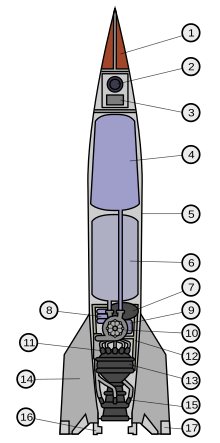Ballistic missile


A ballistic missile ( English ballistic missile ) is a usually military missile that reaches a ground target on a trajectory according to the laws of ballistics . If the peak height is not too great, its trajectory essentially corresponds to that of a floor, a trajectory parabola . Unlike reactive artillery projectiles such as rocket launchers , ballistic missiles are generally guided because of their large ranges . In contrast to cruise missiles and guided missiles , they do not have a supporting structure or a marching engine , but are only driven in the starting phase in order to bring them up to the speed required to reach their destination.
Ballistic missiles are launched from mobile or fixed devices. For missiles with a longer range, the launch angle is usually vertical and is only later deflected into the target direction in order to reduce the influence of air resistance .
Trajectory
The further away the ground target of a ballistic missile, the more its trajectory deviates from the parabolic shape and becomes a ballistic curve , because in addition to the curvature of the earth's surface and the spherical structure of the gravitational field , air resistance has an increasing influence. The latter sinks at very high altitude . The trajectory becomes increasingly elliptical with the approach to the First Cosmic Velocity according to the laws of celestial mechanics and Kepler's First Law .
If the rocket reaches the first cosmic speed on its trajectory, the trajectory is no longer called "ballistic", but runs similar to a satellite path . It results from the initial speed reached at the end of the fire and its angle of inclination to the horizontal.
control
Due to the long flight path, which is significantly longer than the range due to the flight curve, the influence of atmospheric conditions (especially cross winds ) usually prevents target alignment alone at take-off. Thus, the use of a control system is necessary - now mostly an inertial navigation system ( inertial navigation system). This technology was used for the first time in the Second World War with the German A4 rocket (" Vergeltungswaffe 2" - V2). The A4 held by two gyros (gyroscopes) and a timer controlled automatically to the preset target course.
Today, such controls are supplemented by satellite navigation such as GPS or the Russian GLONASS . Control usually only takes place while the engines are burning; in recent times were in response to the further development of missile defense also controllable warheads designed so MARV for ICBMs or about the Russian Iskander -Kurzstreckenrakete.
Military operation
Military ballistic missiles mainly belong to the surface-to-surface missiles and are classified according to their range as specified there. In particular, patterns with a long range can primarily be used against strategic goals. The few air-launched ballistic missiles (ALBM) that have been produced to date and that are launched by strategic bombers or fighter jets include the American AGM-48 Skybolt and the Russian Ch-47M2 Kinschal with hypersonic speed .
The accuracy of a ballistic missile is given as CEP ( Circular Error Probable ) in meters: the radius of a circle around the target point, in which statistically 50 percent of the missiles hit. The most accurate ICBMs reach a CEP of 100 m, the most imprecise ones in service of 5 km.
Civilian use
The “target” of civil ballistic missiles is generally not a place on the earth's surface, but rather the exposure of a satellite or a (short) period of weightlessness, for example for scientific experiments (weightlessness for minutes to hours).
A satellite can be deployed on a ballistic trajectory at its apex - but this then needs its own drive to be able to accelerate further to the First Cosmic Velocity .
Often, however, provision is made for the rocket (s) to fall to the ground again in a defined target area in order to recover the experiments carried out, to be able to reuse the rocket or to avoid endangering people. There are now rockets that can land in an orderly fashion when they return.
literature
- Steven Zaloga : V-2 Ballistic Missile 1942-52. ISBN 978-1-84176-541-9 .
- Tracy Dungan: V-2: A Combat History of the First Ballistic Missile. Westholme Publishing ( information online ( Memento of July 21, 2010 in the Internet Archive )), 2005, ISBN 1-59416-012-0 .
- Heinz Dieter Hölsken: The V weapons: Development - Propaganda - War use. Deutsche Verlags-Anstalt, Stuttgart 1984, ISBN 3-421-06197-1 .
- Olaf Przybilski: Searching for traces Volume 10 - The secret of the German rockets and rocket-propelled aircraft. Podzun-Pallas Verlag, 2002, ISBN 3-7909-0763-4 .
- Gerhard Reisig: Rocket Research in Germany. How humans conquered space. Klaus Lenser agency, Münster 1997, ISBN 3-89019-500-8 .
Web links
Individual evidence
- ↑ ESA: Ballistic trajectory for Ariane 5
- ↑ FAZ .de: Landing of a rocket for the first time after its use on a swimming platform (first stage of a Falcon 9 from SpaceX ).